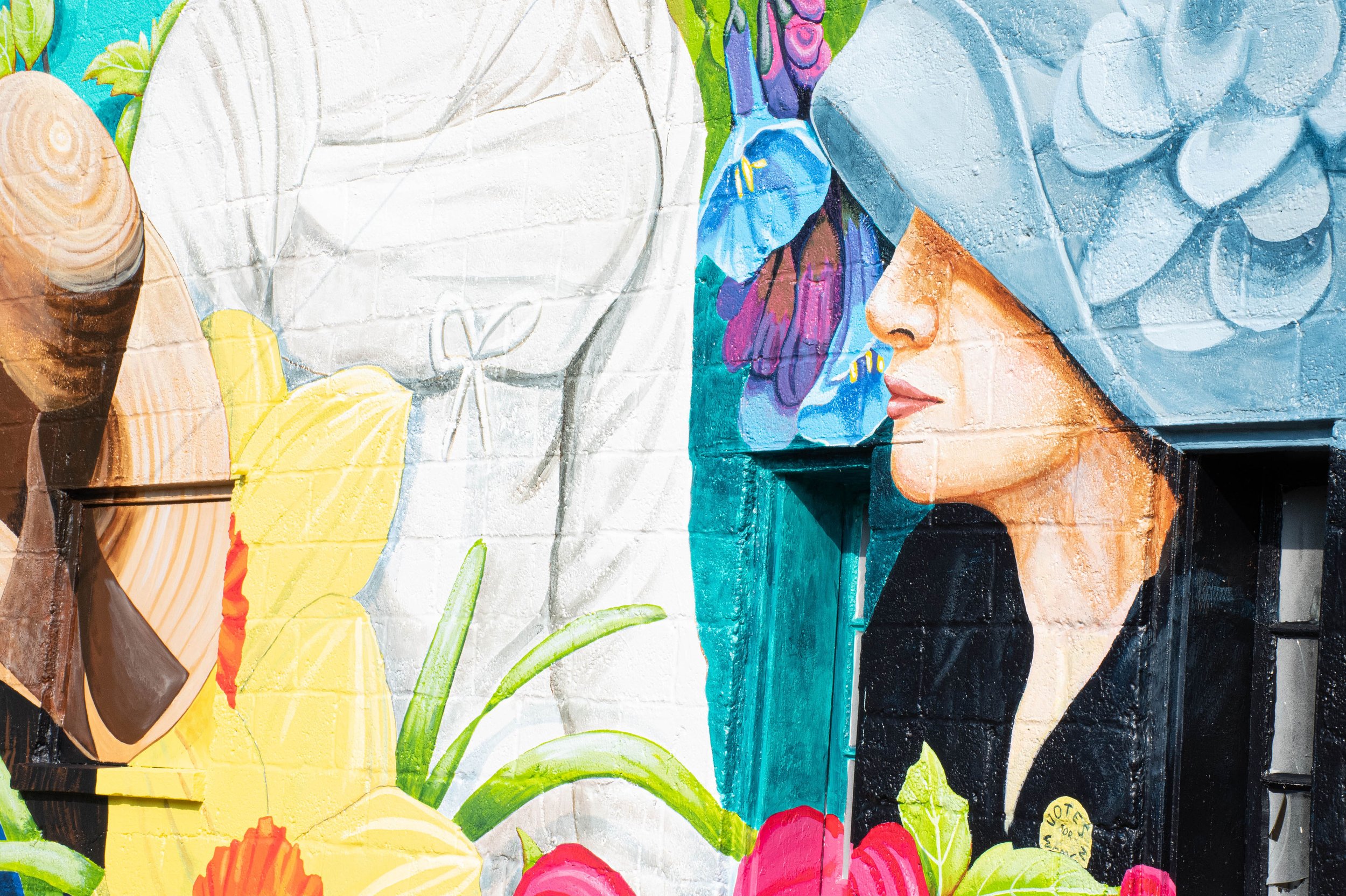New Mural on Main Street Celebrates 250 Years of Women's Contributions
Gloucester's Main Street has a vibrant new addition that's catching the eyes and hearts of locals and visitors alike. A stunning new mural, commissioned by the Cook Foundation, was recently completed and pays homage to 250 years of women's contributions to society and the arts. This colorful masterpiece not only beautifies our historic downtown but also serves as a powerful reminder of the often-overlooked impact women have had on our community and beyond.
A Canvas of History and Inspiration
This new mural is a testament to the talent of artist Bridget Cimino from Baltimore, Maryland. The artwork seamlessly blends historical figures with contemporary icons, creating a timeline of women's achievements that spans a quarter of a millennium.
Key features of the mural include:
Portraits of pioneering women from Gloucester's history
Representations of women's contributions to literature, science, politics, and the arts
Symbols of key moments in the women's rights movement
Woman with Hat - observes the arc of history and the iconic women who transformed Gloucester over the last 250 years.
The Suffragette represents the first women in Gloucester to vote.
Judith Lomax, (1774-1828), a poet from the early 19th century, made a significant contribution to American literature with her collection "The Notes of an American Lyre," published in 1813. Born in Port Tobacco, Maryland, Lomax was one of the first women in the United States to publish a book of poetry under her own name. "The Notes of an American Lyre" is notable for its patriotic themes and reflections on the young nation's ideals and struggles.
Lomax's work often addressed topics such as liberty, virtue, and the natural beauty of America. Despite the cultural constraints of her time, which often limited women's participation in public discourse, Lomax's poetry demonstrated a keen awareness of political and social issues. Her book stands as an important early example of American women's literary voices and provides valuable insights into the perspectives of educated women in the early republic.
Kacey Carneal, (1925-2022), is a renowned artist and community figure from Gloucester, Virginia, whose vibrant work and dedication to the arts significantly impacted the local cultural landscape. Carneal lived and painted in Gloucester for nearly 50 years, her artistic journey began in her youth and flourished over the decades. Her distinctive style, often through bold colors and expressive brushstrokes, captures the essence of Virginia life and nature.
Carneal is particularly known for her paintings of local scenes, wildlife, and holiday gatherings that resonate deeply with Gloucester residents and visitors alike. Beyond her artistic endeavors, she was a driving force in promoting arts education and appreciation in the community. Carneal was instrumental in organizing local art shows, workshops, and collaborative projects that helped nurture emerging talents and strengthen Gloucester's artistic community. Her commitment to the arts extended to philanthropic efforts, often donating her work to support local causes. Through her art and community involvement, Kacey Carneal's legacy is as a celebrated artist, and a beloved figure who has helped shape Gloucester's cultural identity.
Jennie Booth Moton, (1879-1942), was a prominent African American educator and activist in the early 20th century. She dedicated her life to improving educational opportunities for African Americans in the South. Moton attended Hampton Institute (now Hampton University) and later became a teacher at Tuskegee Institute in Alabama. There, she met and married Robert Russa Moton, who would become the second president of Tuskegee after Booker T. Washington.
As the wife of Tuskegee's president, Jennie Booth Moton used her position to advocate for better healthcare and education for African Americans. She was particularly passionate about home economics education and worked to improve living conditions in rural communities. Moton was also active in various women's organizations, including the National Association of Colored Women's Clubs, where she served as president from 1937 to 1941. Her efforts in education, community development, and civil rights made her an influential figure in the African American community during a time of significant racial tension and segregation in the United States.
Mary Shipko is a notable figure in Gloucester, Virginia, known for her significant contributions to aviation and her inspiring life story. Born in 1944, Shipko developed a passion for flying at a young age and went on to become one of the first female commercial airline pilots in the United States. Her career in aviation began in the 1960s when she earned her private pilot's license, followed by her commercial license and instrument rating. Shipko faced numerous challenges and discrimination in the male-dominated field of aviation but persevered to achieve her dreams. She flew for several major airlines during her career, breaking barriers and paving the way for future generations of women in aviation. After retiring from commercial flying, Shipko settled in Gloucester, where she became an active member of the community.
She has shared her experiences through public speaking engagements and her memoir, "Aviatrix: First Woman Pilot for Hughes Airwest," inspiring local youth, particularly young women, to pursue their passions regardless of societal expectations. Shipko's resilience, achievements, and ongoing community involvement have made her a respected and admired figure in Gloucester, embodying the spirit of determination and progress.
Margaret Ann Tunner, (1917-2009), born in 1917, was a pioneering American aviator who made significant contributions to military aviation during World War II and beyond. Known as the "Mother of Strategic Airlift," Tunner played a crucial role in developing air transport operations for the U.S. military. She began her career as a civilian pilot and flight instructor before joining the Women Airforce Service Pilots (WASP) during World War II. After the war, she continued her aviation career and became one of the first women to achieve the rank of colonel in the U.S. Air Force. Tunner was instrumental in establishing efficient air transport systems, particularly during the Berlin Airlift of 1948-1949, where she worked alongside her husband, Lieutenant General William H. Tunner. Throughout her career, she advocated for women's roles in aviation and military service, breaking numerous barriers and setting records in the process. Margaret Ann Tunner's legacy continues to inspire aviators and military personnel, particularly women in aerospace careers. Tunner retired to the beautiful Ware Neck area of Gloucester County.
Irene Morgan, (1917-2007), born Irene Amos in 1917, was a pivotal figure in the American civil rights movement, though her name is often overlooked in historical accounts. In July 1944, eleven years before Rosa Parks' famous act of defiance, Morgan refused to give up her bus seat to a white passenger in Virginia. When arrested, she fought back physically and was charged with resisting arrest and violating Virginia's segregation laws. Morgan's case, Morgan v. Virginia, went all the way to the U.S. Supreme Court, which ruled in 1946 that segregation in interstate travel was unconstitutional. This landmark decision became a crucial precedent in the fight against segregation and inspired the Freedom Rides of 1961. Despite facing significant personal risks, Morgan's courageous stand helped pave the way for future civil rights victories. Her actions demonstrated the power of individual resistance against systemic racism and contributed significantly to the legal dismantling of Jim Crow laws. In 2001, President Bill Clinton awarded Morgan the Presidential Citizens Medal for her contribution to the civil rights movement.
More Than Just Paint on a Wall
This mural is more than just a beautiful piece of art; it's a conversation starter and an educational tool. “This mural shows young girls in our community that they stand on the shoulders of giants and that they, too, can make a lasting impact.”
The mural has already become a popular spot for photos and has sparked increased foot traffic to Main Street businesses. Tourism supervisor for Gloucester County, Susan Ammons, shares, "Since the early stages of the mural began, we've seen more people stopping by, taking pictures, and then exploring what else Main Street has to offer. It's been great for the whole community and visitation."
Community Involvement and Support
The project was made possible through the continual support and facilitation by The Cook Foundation. The foundation just celebrated their 25th anniversary celebrating partnerships within the community, their development of art experiences, and contributing support for a thriving and historic village and Main Street.
As we admire this new addition to our streetscape, we're reminded of the power of public art to educate, inspire, and bring communities together. The mural not only honors the past but also points towards a future where women's contributions continue to shape our society in profound ways.
Next time you're on Main Street, take a moment to stop and appreciate this remarkable piece of art. Let it remind you of the incredible women who have shaped our world and inspire you to consider how you, too, can contribute to the ongoing story of progress and achievement.
For more information on this mural and the others that are along Gloucester Main Street or to learn more about the Cook Foundation please visit https://thecookfoundation.org/murals










